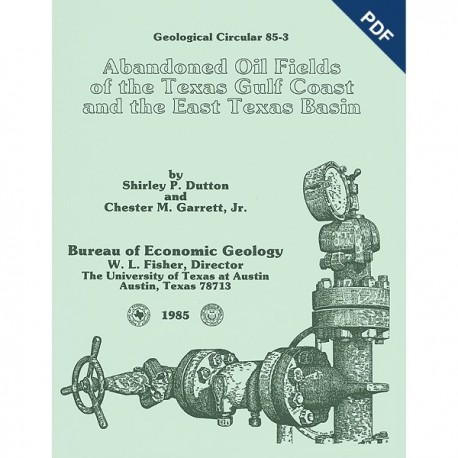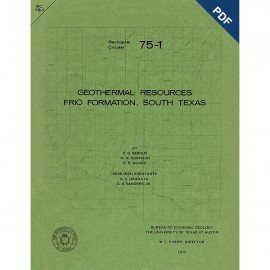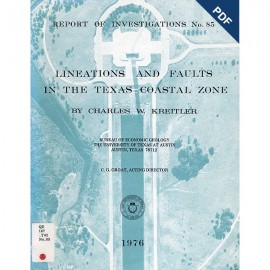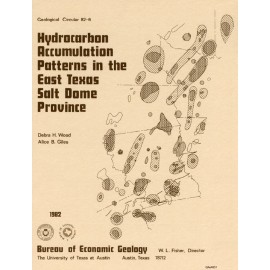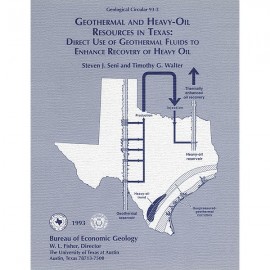Geological Circulars
-
Books & Reports
- Reports of Investigations
- Guidebooks
- Udden Series
- Geological Circulars
- Down To Earth
- Atlases of Major Oil and Gas Reservoirs
- Texas Memorial Museum Publications
- Environmental Geologic Atlas of the Texas Coastal Zone
- Mineral Resource Circulars
- Other Reports
- Seminars and Workshops
- Handbooks
- Submerged Lands of Texas
- Symposia
- Annual Reports
- Open File Reports
-
Maps & Cross Sections
- Thematic Maps
- Miscellaneous Maps, Charts & Sections
- Geologic Atlas of Texas
- STATEMAP Project Maps
- Geologic Quadrangle Maps
- Cross Sections
- Highway Geology Map
- Energy and Mineral Resource Maps
- Shoreline Change and Other Posters
- Wilcox Group, East Texas, Geological / Hydrological Folios
- Bouguer Gravity Atlas of Texas
- River Basin Regional Studies
- Featured Maps
- Posters
- Teachers & the Public
-
Geological Society Publications
- Gulf Coast Association of Geological Societies
- Alabama Geological Society
- Austin Geological Society
- Corpus Christi Geological Society
- Houston Geological Society
- Lafayette Geological Society
- Mississippi Geological Society
- New Orleans Geological Society
- South Texas Geological Society
- GCS SEPM Publications
- Historic BEG & UT Series
Abandoned Oil Fields of the Texas Gulf Coast and the East Texas Basin. Digital Download
GC8503D
For a print version: GC8503.
GC8503D. Abandoned Oil Fields of the Texas Gulf Coast and the East Texas Basin, by S. P. Dutton and C. M. Garrett, Jr. 47 p., 21 figs., 3 tables, 1 plate, 1 appendix, 1985. doi.org/10.23867/gc503D. Downloadable PDF.
To purchase this publication in book format, please order GC8503.
ABSTRACT
One nonconventional target for increased oil recovery in Texas is oil that remains in abandoned reservoirs, defined as reservoirs that produced no oil or gas in 1977 and 1982. This target includes oil in reservoirs that were never subjected to modern secondary or tertiary recovery methods as well as oil that was not tapped by conventional field development because of reservoir heterogeneity. The Texas Gulf Coast and the East Texas Basin (Railroad Commission of Texas Districts 1 through 6) contain 147 onshore abandoned oil reservoirs that had individual cumulative productions of more than 500,000 barrels (bbl) of oil. These 147 reservoirs produced about 231 million bbl of oil before being abandoned. Nongiant fields in the Texas Gulf Coast average about 40 percent ultimate recovery, but a lower figure may be more accurate for the abandoned fields. The original oil in place was about 660 million bbl; if the abandoned reservoirs had an average recovery efficiency of 35 percent, approximately 430 million bbl of oil remain unrecovered. By assuming a residual oil saturation of 20 percent and a water saturation of 25 percent, we can project that about 250 million bbl of the remaining oil is mobile.
The abandoned reservoirs are Cretaceous and Tertiary sandstones and carbonates. The 44 abandoned reservoirs in the Upper Texas Gulf Coast (District 3) produced from various types of plays; plays containing the most abandoned fields are Yegua and Frio deep-seated domes, Eocene deltaic sandstones, and Frio barrier/strandplain sandstones. The 17 abandoned reservoirs in the Middle Texas Gulf Coast (District 2) produced mainly from Wilcox and Frio fluvial/deltaic sandstones and from Frio and Jackson-Yegua barrier/strandplain sandstones. The Lower Texas Gulf Coast (Districts 1 and 4) contains 75 abandoned reservoirs that produced from Frio fluvial/deltaic and barrier/strandplain sandstones, Jackson-Yegua barrier/strandplain sandstones, and San Miguel-Olmos deltaic sandstones. The East Texas Basin (District 6) contains 11 abandoned reservoirs that produced from Lower Cretaceous carbonates, Cretaceous sandstones, and Woodbine fluvial/deltaic/strandplain sandstones.
Keywords: oil recovery, petroleum geology, reservoir characterization, Texas
Citation
Dutton, S. P., and Garrett, C. M., Jr., 1985, Abandoned Oil Fields of the Texas Gulf Coast and the East Texas Basin: The University of Texas at Austin, Bureau of Economic Geology Geological Circular 85-3, 47 p. doi.org/10.23867/gc8503D.
